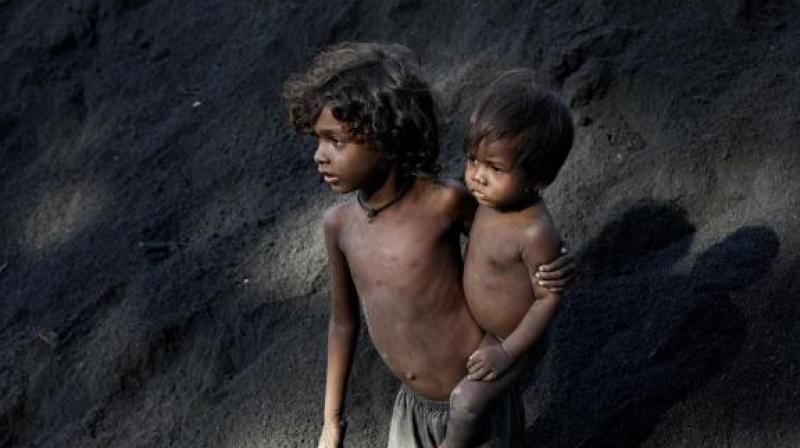Dev 360: Hungry India Are we angry enough?
Populous states like UP, Bihar and MP have made some progress in the battle against child malnutrition but the situation is still very bad.

Do we really trail North Korea and Iraq in the malnutrition stakes? There have been outbursts of anger at India being ranked 100th out 119 countries in the latest edition of the Global Hunger Index by the International Food Policy Research Institute (IFPRI). Experts are quarrelling over the methodology and evaluation parameters and in a hyper-polarised India, it comes as no surprise that the hunger scores have triggered jousts between supporters and critics of the Narendra Modi government.
Has malnutrition really worsened since 2014? The short answer — we don’t know because we don’t have the most recent data.
But does the commotion over such ranks really matter when Santoshi, an 11-year-old girl in Jharkhand, died begging for rice last fortnight? According to a Web portal, the girl died crying for bhaat (rice). Her family didn’t have any. Her family’s ration card was reportedly cancelled because it was not linked to their Aadhaar number, say local Right to Food Campaign activists. With the Durga Puja holidays on, there had been no school, therefore no mid-day meals and no sustenance at home. Santoshi barely had had anything to eat for almost a week. The local authorities say the girl died due to malaria and not starvation. The state’s Chief Minister has announced a probe.
Which brings us to the real issues. Santoshi was not the first victim of malnutrition. She will not be the last. However, it is useful to remind ourselves that even if Santoshi had malaria, her chances of survival would have been far greater had she had minimum nutrition and therefore resilience. Disease fells the undernourished first.
In March this year, in response to an unstarred question in the Lok Sabha, the minister for women and child development said the data regarding the number of deaths from malnutrition is not maintained by the ministry. “Malnutrition is a multi-faceted problem and is not a direct cause of death but contributes to mortality and morbidity by reducing resistance to infections,” the minister said, adding that 14 complaints relating to the deaths of children due to malnutrition had been received by the National Commission for Protection of Child Rights (NCPCR) in the past three years and the current year.
Many of us are angry. But are we angry enough?
The fact is that even if India was a few notches higher, it still would be among the severe cases in terms of the magnitude of malnourishment. While ranking of any particular country is not comparable over years because of changes in methodology and the number of countries covered, there are some facts that cannot be contested. Despite significant economic growth, India continues to trail way behind its peers in many key social indicators, including malnourishment.
What should worry us is that “more than one-fifth of Indian children under five weigh too little for their height, and over a third are too short for their age,” according to IFPRI. And every year, when the UN releases its Human Development Index, there is much hand-wringing about India’s lowly position relative to its peers, but whoops of joy on finding that Pakistan fares even worse.
High degrees of malnourishment and associated illnesses show that India is not investing sufficiently in its people. But look around. Is there any country that has succeeded without investing in its people?
A child’s brain development, cognitive abilities and physical development depends greatly on nutrition. Under-nourished children grow into undernourished adults who are far less productive than those who have had good nutrition. What does this mean for India which has the largest number of children in the world.
One key reason for children being undernourished in the country is that often their mothers are undernourished. In India, one in five women are underweight. Women who are themselves undernourished or get pregnant at an early age are at greater risk of delivering low birth-weight babies, who are nutritionally disadvantaged from the very beginning.
The low status of women in India makes things worse. Women with low or no education and with no say in decision-making in their families often fail to ensure adequate diets for their children even when there is adequate food at home. Food is not the only reason for undernourishment. Lack of sanitation contributes to the spread of infectious diseases. Children fall prey more easily and suffer from diarrhoea. This impacts their ability to absorb nutrients, leading to undernutrition. But building toilets alone will not take care of that. Much more has to be done to make sure that those toilets are well-maintained, connected to water supply and that people use them, realising the links between poor sanitation, disease and growth.
Populous states like UP, Bihar and MP have made some progress in the battle against child malnutrition but the situation is still very bad.
Sensitivity to rankings is fine if the message gets through and is acted upon. But as public health specialist Bobby John puts it, unfortunately it’s the messenger that’s shot more often. Lower international rankings make us prickly, but deaths of children for lack of food or basic medical care does not prick our conscience or consciousness as they should.
This must change if “New India” is to mean anything at all.
